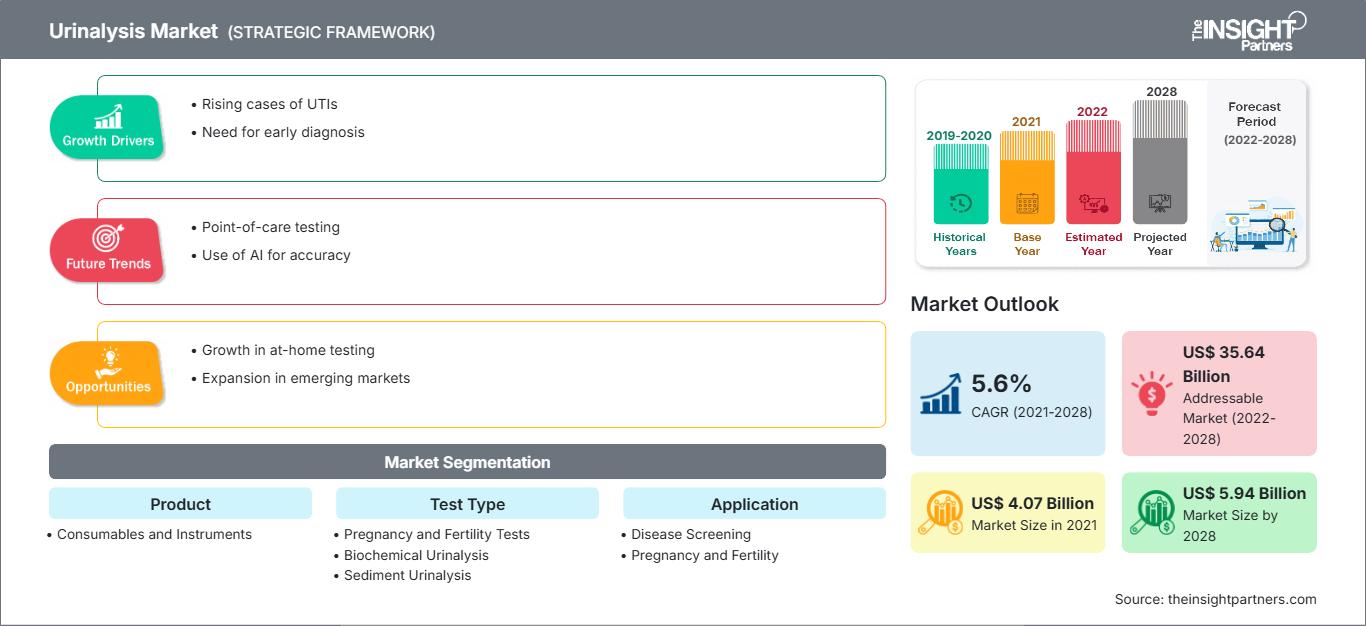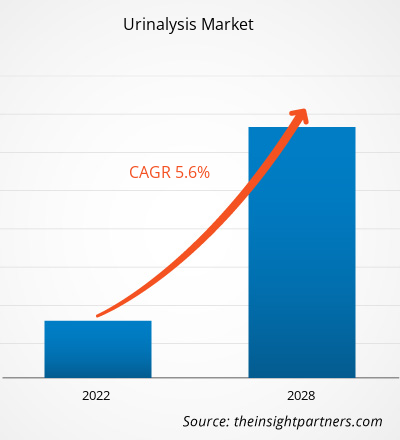Der Markt für Urinanalysen soll von 4.065,79 Millionen US-Dollar im Jahr 2021 auf 5.937,97 Millionen US-Dollar im Jahr 2028 anwachsen; von 2021 bis 2028 wird ein durchschnittliches jährliches Wachstum von 5,6 % erwartet.
Eine Urinanalyse wird zur Diagnose und Behandlung verschiedener Erkrankungen wie Nierenerkrankungen, Harnwegsinfektionen und Diabetes eingesetzt. Dabei wird der Urin mit chemischen, physikalischen und mikroskopischen Methoden auf das Vorhandensein von Medikamenten und krankheitsrelevanten Substanzen, einschließlich Biomolekülen oder anderen Nebenprodukten, untersucht. Die Urinanalyse umfasst die Überprüfung von Konzentration, Aussehen und Zusammensetzung des Urins. Abnorme Ergebnisse oder Werte außerhalb des erwarteten Bereichs können auf eine Krankheit hinweisen. Ein positives Urintestergebnis kann darauf hinweisen, dass die Nieren nicht richtig funktionieren oder das Blut nicht richtig filtern. Es kann auch bei der Diagnose von Herz-Kreislauf-Erkrankungen sowie der Erkennung von Schwangerschaft und Eisprung hilfreich sein.
Der Markt für Urinanalysen wurde nach Produkt, Testtyp, Anwendung, Endverbraucher und geografischer Lage segmentiert. Geografisch unterteilt sich der Markt hauptsächlich in Nordamerika, Europa, den asiatisch-pazifischen Raum, den Nahen Osten und Afrika sowie Süd- und Mittelamerika. Der Bericht bietet Einblicke und eine detaillierte Analyse des Urinanalysemarktes und legt dabei den Schwerpunkt auf Parameter wie Markttrends, technologische Fortschritte und Marktdynamik sowie eine Analyse der Wettbewerbslandschaft der weltweit führenden Marktteilnehmer.
Passen Sie diesen Bericht Ihren Anforderungen an
Sie erhalten kostenlos Anpassungen an jedem Bericht, einschließlich Teilen dieses Berichts oder einer Analyse auf Länderebene, eines Excel-Datenpakets sowie tolle Angebote und Rabatte für Start-ups und Universitäten.
Markt für Urinanalysen: Strategische Einblicke

- Holen Sie sich die wichtigsten Markttrends aus diesem Bericht.Dieses KOSTENLOSE Beispiel umfasst Datenanalysen, die von Markttrends bis hin zu Schätzungen und Prognosen reichen.
Sie erhalten kostenlos Anpassungen an jedem Bericht, einschließlich Teilen dieses Berichts oder einer Analyse auf Länderebene, eines Excel-Datenpakets sowie tolle Angebote und Rabatte für Start-ups und Universitäten.
Markt für Urinanalysen: Strategische Einblicke

- Holen Sie sich die wichtigsten Markttrends aus diesem Bericht.Dieses KOSTENLOSE Beispiel umfasst Datenanalysen, die von Markttrends bis hin zu Schätzungen und Prognosen reichen.
Markteinblicke
Zunehmende Belastung durch Harnwegsinfektionen, Diabetes und Nierenerkrankungen fördert Wachstum des Marktes für Urinanalysen
Laut einer Studie einer Forschergruppe des American College of Physicians und der Infectious Diseases Society of America aus dem Jahr 2020 suchen in den USA jährlich etwa 6 Millionen Menschen einen Arzt zur Behandlung von Harnwegsinfektionen (HWI) auf. Frauen haben ein höheres Risiko, an HWI zu erkranken, als Männer. Einer 2019 im International Journal of Environmental Research and Public Health veröffentlichten Studie zufolge besteht für Patienten mit bestehenden chronischen Erkrankungen wie Diabetes mellitus (DM) ein höheres Risiko, an HWI zu erkranken. Die Nachfrage nach Komponenten für Urinanalysen steigt aufgrund der weltweiten Verbreitung von Diabetes, da Urinanalysen das primäre Diabetes-Screening sind. Laut der International Diabetes Federation (IDF) litten 2019 weltweit rund 463 Millionen Erwachsene (im Alter von 20–79 Jahren) an Diabetes. Bis 2045 dürfte diese Zahl auf 700 Millionen steigen. Laut IDF litten 2019 in Südostasien rund 87,6 Millionen Erwachsene im Alter von 20–79 Jahren an Diabetes, was einer regionalen Prävalenz von 8,8 % entspricht. Rund 56,7 % dieser Diabetesfälle blieben unerkannt. Dies zeigt, dass für die Urinanalyse Potenzial für die Marktentwicklung besteht. Darüber hinaus würden laut einer 2020 von der National Kidney Foundation veröffentlichten Studie rund 35,0 % der Diabetiker über 20 Jahren im Laufe dieses Zeitraums eine chronische Nierenerkrankung entwickeln. Der anhaltende Anstieg von Prostata- und Blasenkrebs macht die Implementierung hochwirksamer Diagnostikverfahren zu einem dringenden therapeutischen Muss.
Die zunehmende Verbreitung von Harnwegsinfektionen, Diabetes und Nierenerkrankungen fördert daher das Wachstum des Urinanalysemarktes.
Produktbasierte Erkenntnisse
Der Urinanalysemarkt ist produktbezogen in Verbrauchsmaterialien und Instrumente unterteilt. Das Verbrauchsmaterialiensegment wird voraussichtlich 2021 einen größeren Marktanteil halten und im Prognosezeitraum eine höhere durchschnittliche jährliche Wachstumsrate (CAGR) verzeichnen.
Testtypbasierte Erkenntnisse
Der Urinanalysemarkt ist produktbezogen in Schwangerschafts- und Fruchtbarkeitstests, biochemische Urinanalyse und Sedimentanalyse unterteilt. Das Segment der biochemischen Urinanalyse dürfte 2021 den größten Marktanteil einnehmen und wird Schätzungen zufolge zwischen 2021 und 2028 die höchste durchschnittliche jährliche Wachstumsrate (CAGR) verzeichnen.
Anwendungsbasierte Erkenntnisse
Basierend auf der Anwendung ist der Urinanalysemarkt in Krankheitsscreening, Schwangerschaft und Fruchtbarkeit segmentiert. Das Segment Krankheitsscreening dürfte 2021 einen größeren Marktanteil einnehmen. Der Markt für dasselbe Segment dürfte zwischen 2021 und 2028 voraussichtlich eine höhere CAGR aufweisen.
Endnutzerbasierte Erkenntnisse
Der Urinanalysemarkt ist nach Endnutzern in Krankenhäuser und Kliniken, Diagnoselabore, häusliche Pflegeeinrichtungen sowie Forschungslabore und -institute segmentiert. Das Segment Krankenhäuser und Kliniken dürfte 2021 den größten Marktanteil halten, während das Segment Diagnostiklabore im Prognosezeitraum voraussichtlich die höchste durchschnittliche jährliche Wachstumsrate (CAGR) verzeichnen wird.
COVID-19 hat den bislang schwerwiegendsten globalen Gesundheitsnotstand dargestellt. Die Lockdowns infolge der COVID-19-Pandemie führten dazu, dass Menschen Gesundheitsuntersuchungen aufschoben, was sich auf die Anzahl der durchgeführten Tests und den Verkauf von Instrumenten, Verbrauchsmaterialien und Reagenzien auswirkte. Der Markt für Urinanalysen verzeichnete zu Beginn der COVID-19-Krise aufgrund von Unterbrechungen der Lieferkette und der Nachfrage aufgrund des von den meisten europäischen Ländern verhängten Lockdowns einen Engpass. Da die Länder jedoch die Bewegungseinschränkungen schrittweise lockern, wird mit einem Wiederanstieg der Testzahlen gerechnet.
Akquisitionen, Kooperationen, Partnerschaften, Produkteinführungen und Expansionen sind gängige Strategien von Unternehmen, um ihre Präsenz weltweit auszubauen und die wachsende Nachfrage zu befriedigen. Die Akteure auf dem Markt für Urinanalysen verfolgen vor allem die Strategie der Produktinnovation, um den sich weltweit ändernden Kundenanforderungen gerecht zu werden und so ihren Markennamen weltweit zu behaupten.
UrinanalyseRegionale Einblicke in den Urinanalysemarkt
Die Analysten von The Insight Partners haben die regionalen Trends und Faktoren, die den Urinanalysemarkt im Prognosezeitraum beeinflussen, ausführlich erläutert. In diesem Abschnitt werden auch die Marktsegmente und die geografische Lage in Nordamerika, Europa, dem asiatisch-pazifischen Raum, dem Nahen Osten und Afrika sowie Süd- und Mittelamerika erörtert.
Umfang des Marktberichts zur Urinanalyse
| Berichtsattribut | Einzelheiten |
|---|---|
| Marktgröße in 2021 | US$ 4.07 Billion |
| Marktgröße nach 2028 | US$ 5.94 Billion |
| Globale CAGR (2021 - 2028) | 5.6% |
| Historische Daten | 2019-2020 |
| Prognosezeitraum | 2022-2028 |
| Abgedeckte Segmente |
By Produkt
|
| Abgedeckte Regionen und Länder | Nordamerika
|
| Marktführer und wichtige Unternehmensprofile |
|
Dichte der Marktteilnehmer im Bereich Urinanalyse: Verständnis ihrer Auswirkungen auf die Geschäftsdynamik
Der Markt für Urinanalysen wächst rasant. Die steigende Nachfrage der Endverbraucher ist auf Faktoren wie veränderte Verbraucherpräferenzen, technologische Fortschritte und ein stärkeres Bewusstsein für die Produktvorteile zurückzuführen. Mit der steigenden Nachfrage erweitern Unternehmen ihr Angebot, entwickeln Innovationen, um den Bedürfnissen der Verbraucher gerecht zu werden, und nutzen neue Trends, was das Marktwachstum weiter ankurbelt.

- Holen Sie sich die Markt für Urinanalysen Übersicht der wichtigsten Akteure
Firmenprofile
- Abbott
- ACON Laboratories, Inc.
- ARKRAY, Inc.
- Beckman Coulter, Inc.
- Bio-Rad Laboratories Inc.
- Cardinal Health Inc
- F. Hoffmann-La Roche Ltd.
- Quidel Corporation
- Siemens Healthineers AG
- Sysmex Corporation
- Historische Analyse (2 Jahre), Basisjahr, Prognose (7 Jahre) mit CAGR
- PEST- und SWOT-Analyse
- Marktgröße Wert/Volumen – Global, Regional, Land
- Branchen- und Wettbewerbslandschaft
- Excel-Datensatz
Aktuelle Berichte
Erfahrungsberichte
Grund zum Kauf
- Fundierte Entscheidungsfindung
- Marktdynamik verstehen
- Wettbewerbsanalyse
- Kundeneinblicke
- Marktprognosen
- Risikominimierung
- Strategische Planung
- Investitionsbegründung
- Identifizierung neuer Märkte
- Verbesserung von Marketingstrategien
- Steigerung der Betriebseffizienz
- Anpassung an regulatorische Trends




















 Kostenlose Probe anfordern für - Markt für Urinanalysen
Kostenlose Probe anfordern für - Markt für Urinanalysen